Showing 85–95 of 95 results
-
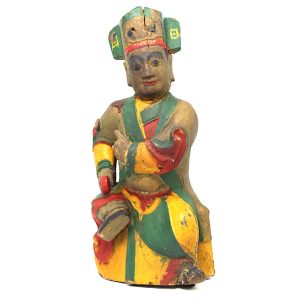
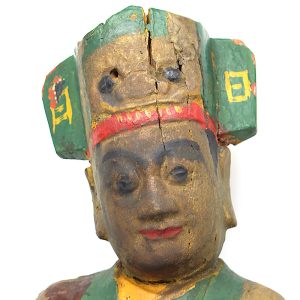
$395.00
H: 13.625” W: 7” D: 5.5” | FREE SHIPPING!
This vibrant carving of a Taoist priest or shaman is in religious attire with double-winged high hat centered with an image of a taotie. Two fingers of hisleft hand are in karana mudra to cast our evil spirits and the tael or silver ingot in his right hand represents a wish for wealth. The closed cavity and the inscription on the back indicate it was consecrated by a Taoist priest.
-
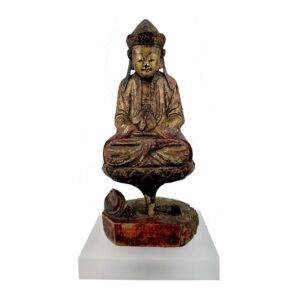
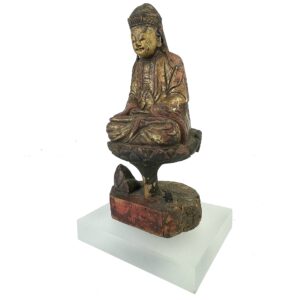
$675.00
H: 10″ W: 5.5 ” D: 4.5″ | FREE SHIPPING!
This charming 18th century provincial Guanyin of the South Sea sits in her cave at Putuo in meditation on a lotus smiling joyously. As a protector of the sea, she is seated on an open lotus above fish with his head and tail emerging from the water. The lotus blossom represents purity and the stem symbolizes Buddhist teachings which give rise to purity of mind.
-
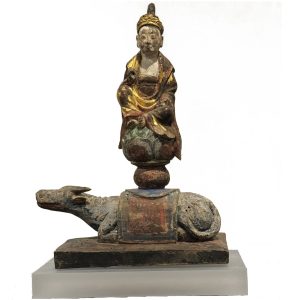
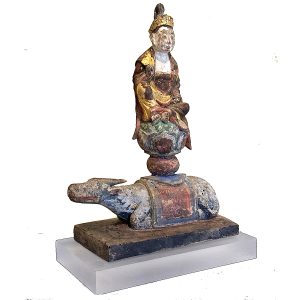
$885.00
H: 10.25″ W: 7.5″ D: 3.75 ” | SHIPPING INFORMATION REQUIRED. CONTACT US AT 213-568-3030
This extraordinary rare and delicately rendered rural carving is a female bodhisattva possibly Guanyin seated on a lotus throne atop an ox. Beautifully highlighted in vibrant gold and adorned with intricate designs on the lotus petals and ox’s saddle coverings, this statue shows how the concept of a bodhisattva was adapted to the deification of “draft animals,” (beasts of burden) who were integral to rural daily and agricultural activities in Chinese Popular Religion, Buddhism and Taoism beliefs.
-
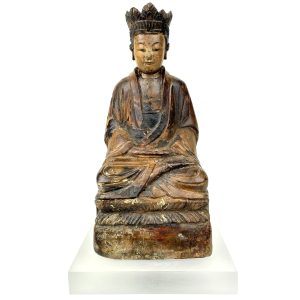
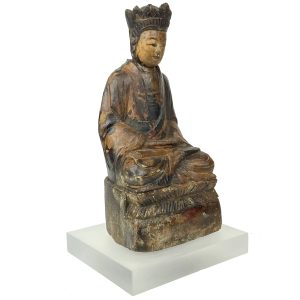
$695.00
Ht: 9.5″ W: 4.5″ D: 3.75″ FREE SHIPPING!
This delicately carved home altar figure is Guanyin represented as gender neutral in meditation on a lotus throne. Her humble demeanor, modest robes and absence of stylized decorative details indicate it was carved by a provincial artisan, and its simple elegance exemplifies the best of provincial Ming and Qing carvings. She is a tranquil figure with simple, soft, and beautifully rendered facial details with almond shaped eyes cast down in serene composure wearing a five-lobed crown symbolically representing the five Dyhani Buddhas and reflecting Vajrayana Tantric influence.
-
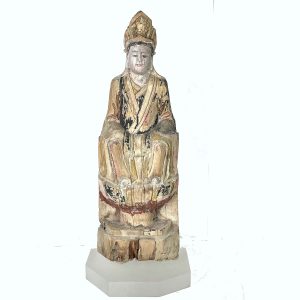
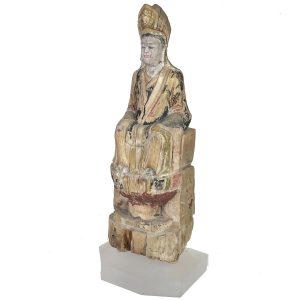
$1,375.00
SOLD H: 23.25″ W: 9.25″ D: 6.25″
This Guanyin image was probably one of a pair of images along with the Taoist Queen Mother of the West (16206A-WACK) placed together on a community, local temple or home altar. Created by the same local artisan, they are provincial rather than imperial style having a humble, unadorned and simple rendering, seated on backless thrones, hands covered by a ritual cloth, uncharacteristic of Guanyin but common for Taoist goddesses. Both wear layered robes and a high pointed crown – the Queen Mother’s centered by a phoenix and Guanyin’s by a flower surrounded by symbolic aureole of radiating light. Both have soft blissful smiles with eyes cast slightly downwards to engage their devotees. Initially covered in bright polychrome colors, there are traces of surviving red, yellow, green, brown and black.
-
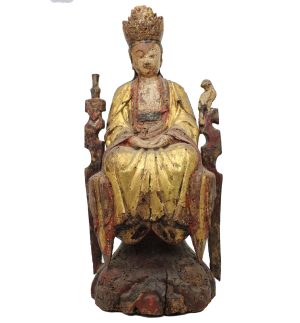
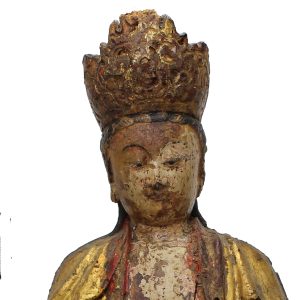
$1,195.00
H: 17.25” W: 9” D: 5” | FOR SHIPPING INFORMATION CONTACT US AT 213-568-3030
This remarkable spiritual work combines characteristics of provincially rendered carvings with imperially sanctioned images of Nanhai Guanyin. She sits in meditation on a backless throne on a stylized rocky outcrop flanked by twisting vertical structures holding her vial and white parrot. Her half-closed eyes glance down serenely under painted arched eyebrows. She wears an arched crown over hair looped over her ears and down her shoulders and flowing gold robes bordered in red in contrast to the flesh tones of the face, chest, and hands. Much of the pigmentation and gilt on this artfully rendered image remains. Surviving depictions of her with the vial and the filial parrot in good condition are relatively rare.
-

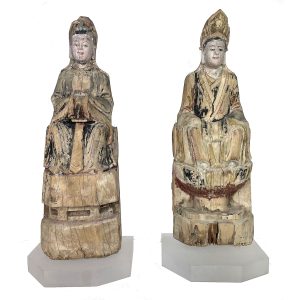
$1,375.00
SOLD | H: 23.25″ W: 9.25″ D: 6.5″
This Queen Mother of the West, the highest ranking female Taoist deity was probably displayed as a pair along a statue of Guanyin, the most significant Buddhism female (Guanyin on a Lotus Pedestal (16206B) highlighting the importance and similarity of these revered female images Like the Guanyin, the Queen Mother’s delicately carved face has half closed eyes, serene composure mouth with a hint of a smile, which is more Buddhist than Taoist. Her headdress, centered by her iconic phoenix, rests under a hood extending to her shoulders and back. She wears a high collared three-layered Taoist robe, her hands covered by a ritual cloth.
-
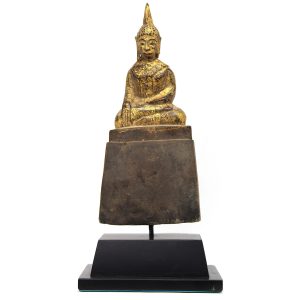
$295.00
H: 9” W: 4.25 D: 3.125” | FREE SHIPPING
This mid 20th century Buddha Shakyamuni in Earth Witnessing position is carved in rural Lao style. Covered with gilt, the small rustic and simply carved image follows Lao artistic canons for depicting a Buddha: a curved hairline and high arched eyebrows that meet at the bridge of the nose, distinct hair curls, long ears, and a flame-shaped radiance emerging from his ushnisha. Its very large base is as tall and wide as the image, reflecting Laotian beliefs that a high pedestal reflects a deep respect for the Buddha. A base has been added for display purposes. Authentic old Lao images, even small personal ones like this, are difficult to find.
-
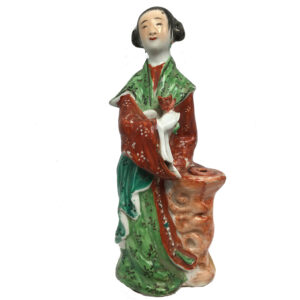
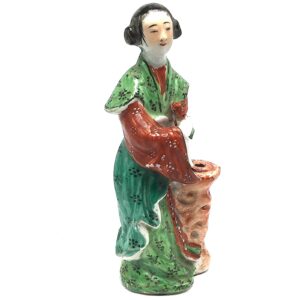
$240.00
This Chinese Republic Period delicate porcelain figurine holds a rose at her heart in her right snow white hand, her left arm covered by her shawl resting on a waist-high decorative vase with an opening to hold incense (joss) sticks. Her shawl drapes over her shoulders and lower garment with floral motifs extending to the beaded belt at her waist. The sweet facial expression with slightly smiling bowed lips is framed by her piled hair looped in a chignon over each ear. Given her luxurious garments and accessories, she is an aristocratic woman. The rose was often used on porcelains during this period, representing eternal spring.
-

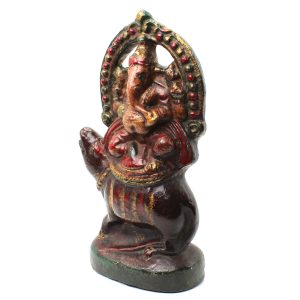
$165.00
H: 9″ W: 4.5 ” D: 2.5 ” | FREE SHIPPING!
This vintage terracotta Ganesh sits on an oversized mouse, his vehicle, holding sweets (laddo) representing earthly prosperity and well-being, a weapon to overcome fear and obstacles, and a conch shell symbolizing victory and fulfillment. The pointed aureole with raised orbs reflected is divine status and energy. Its rustic and earthy style with red, green and gold pigmentation is a fine example of Indian folk art.
-
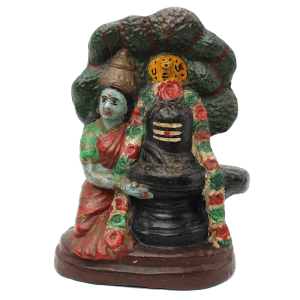
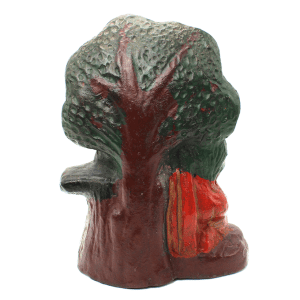
$165.00
H: 8” W: 6” D: 4” | FREE SHIPPING
This colorful terracotta image devotional image of Shiva and Parvati was used for daily puja in a Hindu home. Shiva is represented by a lingham, a symbolic phallus, while Parvati is portrayed as a female deity figure. The dark green tree behind them highlights both of them and a garland of colorful flowers draped over the dark Shiva lingham emphasizes the importance and power of Shiva. The orange and black snake at the apex of the garland is Vasuli, the charm Shiva usually wares around his neck who represents Shiva’s power and fearlessness, while Parvati reaches across to the lingham to designate Shiva as the central focus of the composition.
End of content
End of content



















